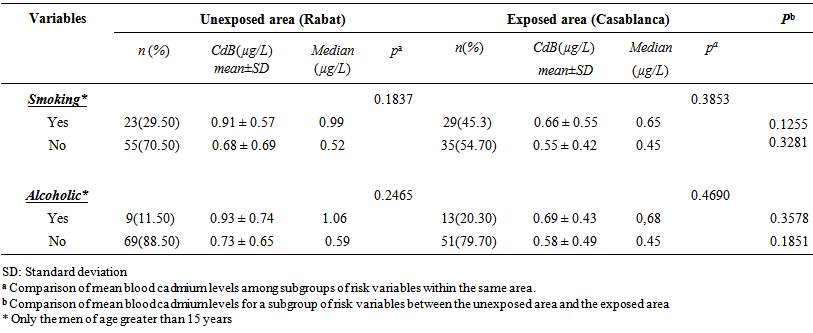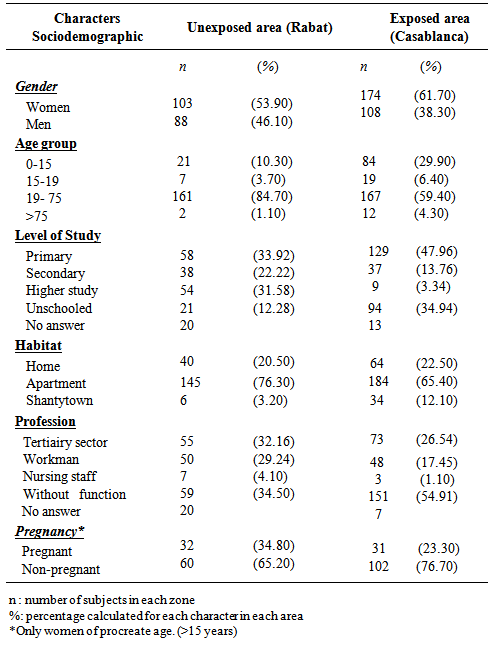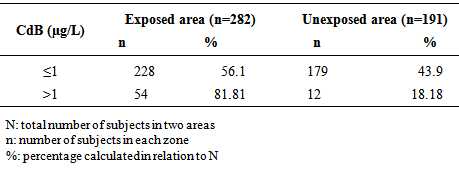-
Paper Information
- Paper Submission
-
Journal Information
- About This Journal
- Editorial Board
- Current Issue
- Archive
- Author Guidelines
- Contact Us
World Environment
p-ISSN: 2163-1573 e-ISSN: 2163-1581
2015; 5(1): 12-16
doi:10.5923/j.env.20150501.02
Evaluation of Impregnation by Cadmium in the Vicinity of an Industrial Source in the City of Casablanca, Morocco
Sanae Shaimi 1, El Khalil Bendriss 1, Moncef Idrissi 2, Hassna Elmamouni 2, Latifa Toufik 2, Rachida Soulaymani Bencheikh 2
1University Abdelmalek Esaadi, faculty of sciences of Tetouan, Tetouan, Morocco
2Center Anti Poison and pharmacovigilance of Morocco, Rue Lamfedel Cherkaoui, Rabat Institutes, Madinate Al Irfane, Rabat, Morocco
Correspondence to: Sanae Shaimi , University Abdelmalek Esaadi, faculty of sciences of Tetouan, Tetouan, Morocco.
| Email: |  |
Copyright © 2015 Scientific & Academic Publishing. All Rights Reserved.
In Morocco, the data on the exposure to cadmium especially among the general population exposed to industrial discharges are still very rare. This study was conducted to estimate the level of cadmium impregnation in the Casablanca region affected by smelter emissions from the town of Ain Sebaa and battery manufacturing companies in the town of Sidi Bernoussi compared to the non-industrial areas in the town of Rabat which has been studied as a control. This work represents a cross-sectional study with 473 non-occupationally exposed subjects. The determination of blood cadmium (Cd-B) was measured after consent of each participant and the collection of demographic data using a questionnaire. The average content of Cd-B found in subjects of Casablanca (0.61±0.50) µg /L was significantly higher than recorded for the in subjects of Rabat (0.51±0.54) µg /L. The level of blood cadmium concentration in the Rabat area decreased from 1,1µg/L in 1997 to 0.51µg/L in 2010, which is the evaluated value in this work reflects a decrease, thus a lower level of exposure to cadmium. We could conclude that the exposition to a high concentration of cadmium in Casablanca is due to chemical emission and industrial discharges.
Keywords: Cadmium, Environmental Exposure, Atomic Absorption Spectrometry, Morocco
Cite this paper: Sanae Shaimi , El Khalil Bendriss , Moncef Idrissi , Hassna Elmamouni , Latifa Toufik , Rachida Soulaymani Bencheikh , Evaluation of Impregnation by Cadmium in the Vicinity of an Industrial Source in the City of Casablanca, Morocco, World Environment, Vol. 5 No. 1, 2015, pp. 12-16. doi: 10.5923/j.env.20150501.02.
Article Outline
1. Introduction
- Cadmium (Cd) is a toxic element that bioaccumulates in the environment [1] especially in industrial areas via atmospheric dispersion and ground contamination surrounding metal emitting industries [2, 3]. It is used in several areas, such as anti-corrosion coating of metals, electric battery ...etc. [1, 4-5]. Waste incineration, wastewater treatment plants, food and cigarettes constitute sources of contamination by Cd [1].Ingested, inhaled or absorbed through the skin, Cd is highly absorbed by the liver and kidneys which accumulates irreversibly over 20 years [1] causing multiple health problems for human beings like Itai-Itai syndrome, which is defined by the combination of kidney failure, osteoporosis and osteomalacia [6].Cd is considered as a carcinogen factor by most regulatory bodies in their latest assessment of the cancer risk, IARC (1993) classifies it as a human carcinogen Group I, the evidence of carcinogenicity was sufficient with a large incidence of cancers of the lung, the prostate, the pancreas. The EU (2004) has classified Cd in category 2, US EPA (1992) in class B1 and IARC Monographs (1993) in group1 [4].Many international studies have been devoted to study and monitor the deleterious effects of Cd [6-8]. However, in Morocco, the studies to monitor exposure to Cd-exposed workers as well as among the general population, not occupationally exposed, are very limited [9, 10]. In this context, this study was conducted to measure the level of cadmium in blood (Cd-B) in the urban population of Casablanca exposed to inhaled particles of Cd from smelters and battery manufacturing companies of towns of Ain Sebaa and Sidi Bernoussi and identify factors intentional contamination by Cd.Casablanca is the first industrial poll in Morocco and is heavily contaminated.
2. Methods and Materials
2.1. Study Areas
- These are the towns of Ain Sebaa and Sidi Bernoussi of Casablanca city, a heavily industrialized area with a population could be exposed to the inhalation of atmospheric emissions of Cd and ingestion of fallout on the ground near industrial source and Rabat is chosen as a control unexposed industrially area. The two populations share the same sociodemographic criteria like gender, age and socio-professional categories. The industrial area of Ain Sebaa and Sidi Bernoussi represent the first industrial center of the Casablanca city and the whole country, it is a vast area that combines factories and homes. It is characterized by a semi arid and sub-humid climate with temperatures between 13 and 30°C. Annual rainfall ranges between 300 and 500 mm and the average wind speed is 4m /s.
2.2. Survey and Study Populations
- This is a cross type study of exposed and unexposed populations, which is part of a project entitled EVEXMEL (assessment of exposure to heavy metals) initiated three years ago by the anti-poison and Pharmacovigilance Centre of Morocco. It was conducted with a sample of two degrees, a first degree stratification was done on the area, the second was made on the choice of the nearest health centers of industrial source, participants were included in "all comers" in services while respecting the inclusion criteria. In Casablanca, 282 subjects including children and adults (174 female and 108 male) not occupationally exposed, and residents in the exposed area for 6 months, as the time may reflect the body burden after recent exposure to Cd [1], were recruited from six health centers nearest industrial sources.In Rabat, a total of 191 children and adults (103 female and 88 male) not occupationally exposed and residing in the unexposed area were all recruited at the maternity and pediatric department of University Hospital Center and blood transfusion center of Rabat. We excluded anyone who does not meet the inclusion criteria and who suffers from high blood pressure, diabetes, kidney or heart problems.All participants were well informed (parents for children) about the experience and their consent was required.
2.3. Sampling and Analysis of Samples
- A blood sample was collected, volunteers, each participant meeting the criteria for inclusion in a 5ml tube with EDTA as an anticoagulant and stored at -20°C.Each blood sample after thawing was diluted to 1:4 with acidified water (nitric acid having a purity of 69% / distilled water, V / 7V) and left for 18 hours before centrifugation at 4000 rpm (~ 1800 g) for 10 min. After centrifugation, the supernatant was diluted to 1:2 with a solution containing water acidified with the standard solution of Cd.The dosage of Cd-B has been made in the poison center and Pharmacovigilance of Morocco by atomic absorption spectrophotometry using a graphite furnace model SHIMADZU 6800 with an automatic injector. The main parameters used in the conditions of the laboratory for the determination of the Cd-B are: a wavelength 228.75nm, a lamp current of 8mA, drying at 100°C, decomposition at 550°C, atomizing 2200°C, an internal control was processed after each series of five samples, repeatability was greater than 95%, the limit of detection (LOD) and limit of quantification (LOQ) were set respectively 0.03μg/L and 0.12µg/L. This technique was inspired by the literature [11, 12].
2.4. Statistical Analysis
- Excel and Epi Info 1.3.5 software were used for gathering and analyzing the data.Qualitative variables were described by their frequencies and quantitative variables including the concentrations of Cd-B have been described by their mean, median, and standard deviation. The chi2 test was used to check the distribution of exposed/unexposed groups. The significance level was set at p <0.05. The analysis of variance by the ANOVA test was used in comparing the mean concentrations of Cd-B. The threshold of statistical significance was set at p <0.05.
3. Results
- In the present study we included 473 subjects from different socio-demographic groups (Table 1) with a mean age of 30.21 ± 17.68 years of 282 (69.6%) participants in the exposed area (174 female and 108 males) and 191 (40.4%) participants of the unexposed area (103 female and 88 male). Using the Chi2 test showed that the two populations are homogeneous in terms of sociodemographic characteristics (p=0.0498).
|
|
|
 | Table 4. Means of Cd-B as a Function of Gender, Age and Pregnancy of Unexposed Area (Rabat) and Exposed Area (Casablanca) |
 | Table 5. Means of Cd-B Depending on the Variables Studied for the Unexposed (Rabat) and Exposed Area (Casablanca) |
4. Discussion
- There is evidence that human beings are being exposed to pollution by Cd, especially by inhalation of cigarette smoke, food and by living in the vicinity of industries releasing Cd particles [1-3]. It’s causing a lot damage to kidney function and has a carcinogenic effect [15, 16] Thus, the problem of this toxic element is placed globally with the aim to reduce its emissions by phasing out its use. In Morocco, a signatory to international conventions on the management of hazardous substances is also challenged to contribute to these international actions, in this context, the risk assessment due to emissions of heavy metals including Cd is among the priorities of the national action plan developed to improve the management of hazardous substances and reducing pollution from these elements. In this framework and given that few studies have been developed to study environmental exposure to Cd in the vicinity of industrial sites [9], we try by this work to measure the importance of environmental poisoning by Cd in urban communes of Ain Sebaa, and Sidi Bernoussi.According to our results, the average concentration of Cd-B in the general population of Rabat was 0.51±0.54 µg/L. This value is much lower than the value of 1.1μg/L found in the study conducted in Rabat in 1997[10] Thus, similar surveys have reported the same result by Czech Republic, Cd-B concentration was 1.1 µg/L in 2001, it was 0.5µg/L in 2005 and was still down 0.3μg/L in 2007 [17]; This significant decrease in the average concentration of Cd-B in the population of Rabat trends to levels reported by other countries. For example, in Italy, in 2010, the average concentration in 215 subjects was 0.53μg/L [3], USA, in 2011, the average concentration in 599 subjects was 0.30μg/L [18], Germany in 2005, was 0.58μg /L in non-smoking subjects in general population [2]. This decrease can be attributed to the efforts of the authorities in the fight against cigarettes by banning smoking in public spaces. Also by the proper use of phosphate fertilizers, which can potentially be a significant source of heavy metals that are transmitted to humans through plants and organs meats, such as cereals (rice, wheat ...), green leafy vegetables (lettuce, cabbage, spinach ...) and giblets (liver, kidneys ..). In addition, authorities are developing policies and adopting reforms to reach a low level of emission of toxic elements in atmosphere.In both areas, we observed that the concentration of Cd-B is influenced by gender [19-22]. This could be explained by the facts that in Morocco men smoke more than woman. In Casablanca, the significantly high concentration of Cd-B found in children and women regardless of their state of pregnancy could be attributed to exposure to pollution from industrial emissions, in fact, children are exposed by inhaling and ingesting particles from air and ground contamination. However, men despite their exposure did not show a concentration of Cd-B significantly different than that of men in Rabat, it is assumed that men probably recruited in Rabat are more exposed to cigarette smoke, knowing that the cigarette smoke is able to increase the concentration of Cd-B 1.5 to 3 times normal concentration [19]. Despite of the harmful effects of smoking and excessive consumption of ethanol in alcoholic beverages which increases the permeability of biological membranes of Cd [23], no significant difference was demonstrated in relation to smoking and alcohol (p> 0.05) which shows that these factors are not presented as risk factors in this work.Our results are consistent with several studies, conducted to monitor the concentration of Cd-B from industrial sites [2] showed that exposure to industrial waste 2008, following a cross-sectional study with 278 children, the average concentration of Cd-B in the inhabitants of the industrial zone was 1.58μg/L against 0.97μg/L in the unexposed area [24], Belgium in 2007, according to a similar survey of 431 subjects, it was 1.1μg/L in the exposed against 0.7μg/L in the control zone [8].
5. Conclusions
- In conclusion, the high concentration observed in the population of Casablanca compared to Rabat may be due to neighbouring environmental contamination of polluted industrial sites. Furthermore the impregnation of cadmium in the Moroccan population has declined since 1997 to be within levels generally below the threshold value of the general population of not occupationally exposed and non-smoking and closer values internationally [3, 18]. These results can motivate the authorities to continue their efforts in the improving the environmental protection policy.
 Abstract
Abstract Reference
Reference Full-Text PDF
Full-Text PDF Full-text HTML
Full-text HTML

